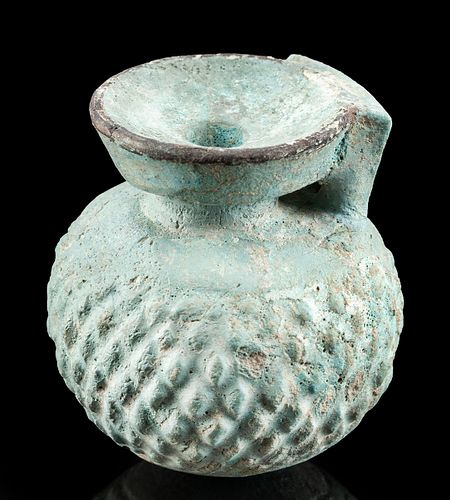Rare Greek Rhodian Glazed Faience Aryballos
Lot 17g
About Seller
Artemis Gallery
686 S Taylor Ave, Ste 106
Louisville, CO 80027
United States
Selling antiquities, ancient and ethnographic art online since 1993, Artemis Gallery specializes in Classical Antiquities (Egyptian, Greek, Roman, Near Eastern), Asian, Pre-Columbian, African / Tribal / Oceanographic art. Our extensive inventory includes pottery, stone, metal, wood, glass and textil...Read more
Categories
Estimate:
$2,000 - $3,000
Absentee vs Live bid
Two ways to bid:
- Leave a max absentee bid and the platform will bid on your behalf up to your maximum bid during the live auction.
- Bid live during the auction and your bids will be submitted real-time to the auctioneer.
Bid Increments
| Price | Bid Increment |
|---|---|
| $0 | $25 |
| $300 | $50 |
| $1,000 | $100 |
| $2,000 | $250 |
| $5,000 | $500 |
| $10,000 | $1,000 |
| $20,000 | $2,500 |
| $50,000 | $5,000 |
| $100,000 | $10,000 |
| $200,000 | $20,000 |
About Auction
By Artemis Gallery
Feb 13, 2020
Set Reminder
2020-02-13 10:00:00
2020-02-13 10:00:00
America/New_York
Bidsquare
Bidsquare : Exceptional Antiquities, Asian, Ethnographic
https://www.bidsquare.com/auctions/artemis-gallery/exceptional-antiquities-asian-ethnographic-4848
An important one-day auction featuring museum-worthy examples of Egyptian, Greek, Roman, Etruscan, Near Eastern, Far East / Asian, Pre-Columbian, African / Tribal, Oceanic, Native American, Spanish Colonial, Russian, Fossils, Ancient Jewelry, Fine Art, so much more! Artemis Gallery info@artemisgallery.com
An important one-day auction featuring museum-worthy examples of Egyptian, Greek, Roman, Etruscan, Near Eastern, Far East / Asian, Pre-Columbian, African / Tribal, Oceanic, Native American, Spanish Colonial, Russian, Fossils, Ancient Jewelry, Fine Art, so much more! Artemis Gallery info@artemisgallery.com
- Lot Description
Western Greece, Rhodes, Archaic Period, ca. first half of the 6th century BCE. A beautiful mold-formed faience aryballos of a petite scale with a rounded base bearing an impressed circular groove, a spherical body with dense lattice-pattern motifs in low relief, a smooth shoulder that tapers inward to a narrow neck, a broad rim with a flared lip, and a wide handle joining rim to shoulder. The vessel is enveloped in a layer of blue-green glaze, and a ring of black pigment courses around the lip. The rarity of this vessel stems from the use of faience - a distinctly Egyptian technique - in the Greek Isle of Rhodes during the height of the Greek Empire. Rhodian aryballoi would have contained oils or other uncommon liquids, and faience vessels like this example would have been owned by only the wealthiest Greek families, perhaps with close ties to Egypt through trade. Size: 2.1" W x 2.25" H (5.3 cm x 5.7 cm)
For a strikingly similar example with vertically striated body patterning, please see The British Museum, museum number 1861,0425.24.
A nearly identical example of a slightly taller form, along with two other items, hammered for $13,750 at Sotheby's, New York "Antiquities" auction (December 5, 2007, part of lot 135).
Provenance: private East Coast, USA collection; ex-Artemis Gallery; ex-private New Jersey, USA collection; ex-William Froelich collection, New York, USA, acquired in the 1970s
All items legal to buy/sell under U.S. Statute covering cultural patrimony Code 2600, CHAPTER 14, and are guaranteed to be as described or your money back.
A Certificate of Authenticity will accompany all winning bids.
We ship worldwide and handle all shipping in-house for your convenience.
#152728Repaired from a few large pieces, with light restoration to areas of body, shoulder, handle, and rim, with resurfacing and overpainting along new material and break lines. Minor nicks, abrasions, and pitting, with light fading to areas of original glaze pigmentation, and light encrustations. Light earthen deposits and nice traces of original glaze pigment throughout.Condition
- Shipping Info
-
All shipping is handled in-house for your convenience. Your invoice from Artemis Gallery will include shipping calculation instructions. If in doubt, please inquire BEFORE bidding for estimated shipping costs for individual items.
-
- Buyer's Premium



 EUR
EUR CAD
CAD AUD
AUD GBP
GBP MXN
MXN HKD
HKD CNY
CNY MYR
MYR SEK
SEK SGD
SGD CHF
CHF THB
THB
















